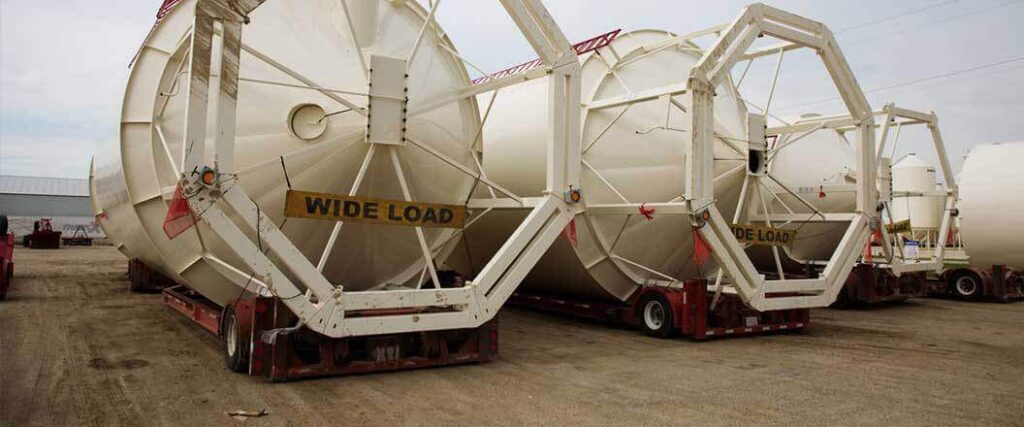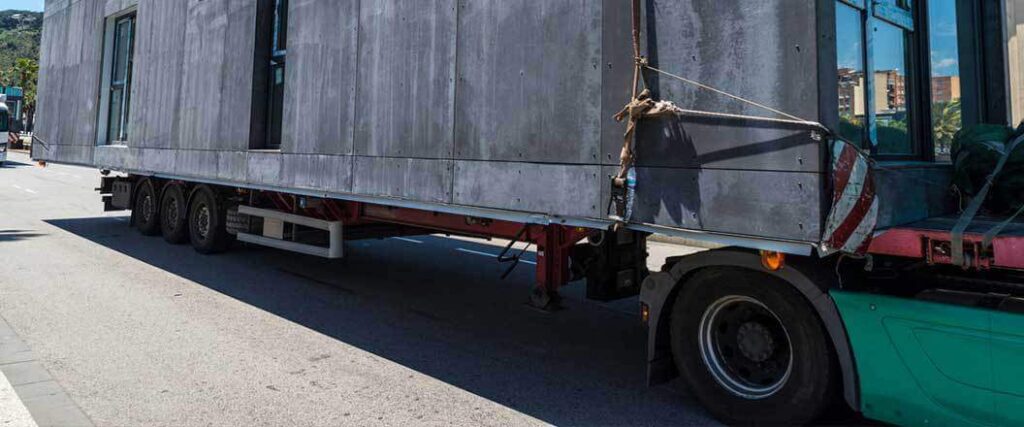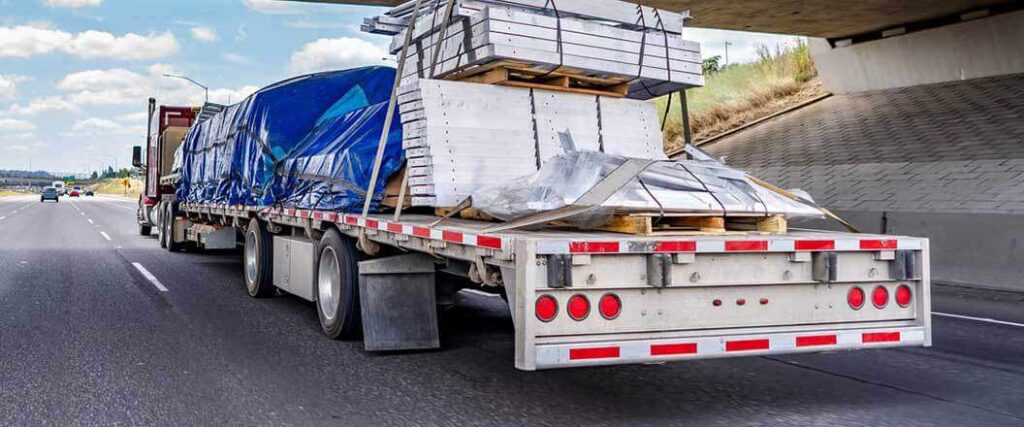Wide load vs oversize load limits face slightly different challenges. Both load classifications mean you are hauling something potentially dangerous to yourself and other vehicles on the road. Despite the risks, millions of dollars worth of oversized cargo are transported safely across North America daily.
The U.S. Department of Transportation (DOT) uses Federal standards to place weight limits on commercial vehicles traveling on national interstates. The limits for width, height, and length are set by each state rather than by Federal mandates. Loads that exceed Federal or State limits are considered wide and oversize loads.
Proper precautionary measures can minimize risks and make wide and oversize loads safe to transport.
For legal purposes, there isn’t a need to define wide load hauls and oversized hauls as unique terms. However, for technical purposes, it can be said that all wide loads are oversize, but not all oversize loads would be classified as wide loads.
Despite not having a Federal maximum, width is uniform in all states because of standard road measurements. A wide load would be considered anything beyond eight and a half feet in width, or anything that would hang over the edge of a standard flatbed trailer.
Defining an oversized load can be a little tricker. Even if the load isn’t overly wide or tall, its weight can still place it in the oversize category.
In terms of weight, there is a federal standard.
Although most people think of flatbed trailers when oversize loads are mentioned, this isn’t always the case. Overweight dry van trailers can also be classified as oversized. A dry van can haul between 43,000 and 46,000 pounds. Depending on the weight of the trailer and rig, the total gross weight can exceed 80,000 pounds.
The weight limit applies to all interstate highways, known as the National Network. A truck moving in-state on private roads can actually have a higher limit if the state regulations are slightly higher than the federal ones.
All else being equal, however, length and height are the factors that vary most from state to state. In one state, the length maximum of a standard load might be 53 feet, but in another, it’s 48 feet. Therefore, in one state the cargo would be considered an oversize load, but not in the other.
Because of these differences, the oversize classification may depend on the state and route that the truck will travel through.
Working with an experienced carrier or Third Party Logistics (3PL) company familiar with oversize load regulations will increase the success rate of your shipments.

Regulations on load weight and size are in place for a reason. Hauling oversized loads does involve a higher risk to drivers, loaders, and fellow motorists on the road. If you are looking for a carrier to move oversized or wide freight, you need a company experienced in heavy haul.
Oversized shipments are also going to cost you more when compared to a standard dry van or even a flatbed rate. This is because oversized cargo is considered high-value/high-risk for carriers.
From this point on, the terms wide load and oversize load will both be used to refer to shipments that exceed any dimension or weight limits.
More information can be found in the article, "Oversized Cargo Transport: A Massive Undertaking".
First, let’s finish clarifying the Federal regulations involving oversized loads. Many of the regulations that have to do with weight, length, and width have their origins in the 1982 Surface Transportation Assistance Act (STAA) of the United States.
Among the many STAA provisions is the one that allows vehicle and cargo limits to be revised for the Interstate System. These provisions are outlined in 23 CFR Section 658.
In addition to the weight limits for the National Network, bridge weight limits are calculated separately. The Bridge Gross Weight Formula applies to all bridges on interstate highways.
Bridge Gross Weight Formula:
If the calculated weight is greater than 80,000 pounds, it will be considered oversized. The truck would need a state-issued permit for specific bridges.
For length, STAA sets limits that states can’t go below, in terms of their own oversize load requirements. This keeps states from declaring an unfairly short trailer as oversized just so they can charge a permit for it.
| Truck-semi trailer combinations | 48 feet |
| Truck-semi trailer-trailer combination | 28 feet |
| 5th Wheel car or boat carrier | 65 feet |
| Stinge-Steered car or boat trailer | 75 feet |
| Saddle-Mount Vehicle transport | 97 feet |
Width has less fluctuation. In all states, except Hawaii, any vehicle or load that is wider than eight and a half feet is considered oversized. The maximum width allowed in Hawaii is actually nine feet due to local road planning. Although this standard is stated in STAA, it is enforced by state laws instead of federal laws.
There is no Federal rule controlling minimum or maximum vehicle or trailer height. Bridges and overpasses, especially those built before larger cargo trucks were so common, will have lower height limits. Newer construction along interstate highways has a standard design clearance between 16 to 17 feet depending on the state.
A truck’s route should be double-checked for height minimums along its entire length to prevent low clearance accidents along the way.

Reach out to us at (855) 490-2433 or fill out our quick form and a live agent will be in touch shortly to help with the equipment and permits you need.
Oversize load regulations at the state level need to exist within current Federal standards. At the moment, each state individually enforces oversize load regulations and permitting.
Not every truck needs to travel out of state or even on highways that are part of the National Network. This allows states to customize laws to fit common infrastructure. States with large cities and an abundance of industrialized and populated areas may have stricter regulations than a state with more rural infrastructure.
For example, let’s look at the regulations for Idaho, a more rural midwest state, and Massachusetts, a highly industrialized state.
Only 0.6% of Idaho is covered by urban areas, compared to 38% of Massachusetts. Both states have the standard width limit of 8 feet 6 inches. The height limit in Idaho is 14 feet statewide, but in Massachusetts, there are some areas where loads can’t exceed 12 feet 6 inches.
Additionally, there are some routes in Idaho that are approved for loads weighing up to 129,000 pounds. That’s 49,000 pounds over the Federal legal limit on the interstate system.
The takeaway here is that if you are transporting a load across state lines, check the wide load and oversize load standards in each state. Some states will issue a permit if your loads go over their limits. In other places, you might simply need to find an alternative route or a way to divide your cargo.
Check with the Federal Highway Administration (FHWA) Freight Management and Operations page for links to each state’s oversize load regulations.

In the majority of states, a wide load permit is necessary once the width of a load exceeds 8 feet 6 inches. There are different levels of permits depending on a number of factors.
Other factors that could affect permit needs are:
Aside from situations where a load will not physically fit through an intended route, such as a tunnel or bridge, a permit can be issued to move just about anything.
Of course, width isn’t the only determining factor. A load that exceeds any dimension limit, such as weight, length, or height, will need to get a permit.
Application for an oversize load permit or wide load permit (if the state makes a distinction) is done at the state level. If you have to cross multiple states, you will need a permit from each one.
Most applications go through a state’s Department of Transportation or Department of Revenue office. Once you have confirmed that a permit is required, gather additional information as needed.
Remember that the carrier will be applying for the permit. Accurate information will minimize errors and delays.
Common permit application information includes:
Once this information has been provided and approved, a permit can be granted. The cost of a permit changes from state to state, but most average between $15 to $70 depending on the details of the load.
If a state provides an automated permit system, the entire process can be done online. A transport company that frequently works with oversized cargo may be able to pull multi-haul permits or even annual permits.
Once granted, permits include the necessary information for local authorities that show you are legally transporting oversized loads. It will also indicate whether special equipment or other services are required.
Permits will detail the following information:
If you work with a dedicated carrier for most of your hauls, you may be able to catch a price break with some permits. This is where it pays to develop a long-term relationship with transportation services, especially if you know you’ll be shipping frequently.

Some loads are riskier to move than others. The nature of the load, bad weather, and the behavior of other drivers on the road all contribute to potential safety hazards.
That being said, so long as all proper safety measures are put in place, an oversized load can be moved safely just like any other.
The vast majority of oversized cargo is moved by some kind of flatbed trailer, sometimes even one that has been customized for a particular job. Safety accessories used with wide loads are there to warn other drivers and hopefully protect both truck drivers and cargo.
Understanding the dangers of moving oversize cargo can help shippers and carriers make safety a priority.
Experienced heavy haul drivers are well aware of these risks and know to take proper precautions. At each stop, cargo should be inspected for loose ties, substantial shifting, and working warning lights.
Common oversize loads include construction and farming equipment such as bulldozers and tractors. Any loose parts should be tightened or otherwise secured. Depending on the type of vehicle and travel distance, it might be necessary to empty fuel tanks, disconnect batteries, or drain other kinds of fluid.

We know the proper permit state requirements. Get your heavy cargo moving on schedule with a personalized quote from our industry experts!
Travel restrictions for oversize loads will depend on the state and on how oversized the load is. In short, most states do restrict travel times for oversized load transport. Because of the dangers associated with oversized loads, the goal of most restrictions is to limit movement when traffic will be at its worst.
States, and sometimes even individual cities, prohibit oversized load movement during the following times:
Whether a truck is allowed to move at night is also dependent on different circumstances. For wide loads less than 10 feet, night travel is usually still allowed. Special lights might be needed, but otherwise, it’s business as usual.
Trucks that require escorts or pilot vehicles can’t get on the road until 30 minutes before sunrise. They have to get off the road no later than 30 minutes after sunset. While not a federal law, nearly every state imposes this limit.
Of course, there are exceptions to these rules too. Sometimes carriers have no choice but to move oversized cargo at night when traffic is minimal.
The “Levitated Mass” boulder was transported through some of the most densely populated areas of California to Los Angeles for an art exhibit. Weighing 680,000 pounds, it could only be moved at night and rarely moved more than eight miles an hour. It took 11 days to move this monolith a little over 100 miles.
While obviously a very specialized load, it shows that just about anything can be shipped given the right equipment and time. These are sometimes referred to as over-dimensional freight and each one may need unique services.

When permits require the use of escort vehicles, it’s important to understand what kind and under what circumstances. Referred to as Pilot/Escort Vehicle Operators (P/EVO), these drivers will either be ahead of a truck and/or behind. Permits will state when one or both are needed.
While regulations vary by state, an escort and/or pilot vehicle is normally required for wide loads greater than 10 feet in width. If the load is between 10 and 12 feet, only a rear escort vehicle may be needed. For loads between 12 and 14 feet moving during the day, a rear escort vehicle and a front pilot vehicle are called for.
Any loads greater than 16 feet in width would likely require parts of a route to be closed off to regular traffic.
If the nature of the load is sensitive or it needs to move through potentially dangerous areas, the permit may also state that one or both of the P/EVO be police units.
Each vehicle plays a different role in keeping the truck and its cargo safe.
The pilot vehicle’s responsibilities include:
An escort vehicle’s responsibility includes:
P/EVO drivers are contracted by carriers when permits require it. The majority of states require specific driver credentials and lists of equipment that pilot and escort vehicles must carry.
Certification courses are available through the FHWA and cover specific laws in each state. The actual tests are conducted by the states.
Aside from P/EVO certification, a state may also require the following:
Since these vehicles need to stay with a truck for the length of the journey, they also need to have copies of the oversize load permits for each state they may pass through and the specific route information.

Necessary equipment will depend on the kind of oversized load that needs to be moved. If the only dimension putting a load in the oversize category is width, there is a chance that the item can be shipped on a standard flatbed trailer.
When length and weight are past the standard, special-made heavy equipment is needed. A carrier may need to add axles to a flatbed to better distribute weight or even use a specialized flatbed chassis.
Loading oversized equipment is another matter. Loads that can move on their own power, such as construction vehicles, are usually driven onto an appropriate flatbed. Other loads may need the assistance of cranes or forklifts.
Shipments requiring special assistance for loading include:
Drivers should make sure that all needed safety straps for load securing are in good condition and tightly secured. Frayed or loose straps can break during transit or in the loading and unloading process.

Reach out to us at (855) 490-2433 or fill out our quick form and a live agent will be in touch shortly to arrange your successful transport from state to state.
Additionally safety precautions include the use of special flags and signs. These must be DOT approved and are required by law for wide load and oversize load transportation.
Exact signage requirements will be laid out in the state permit. As a general rule, most of the following are standard.
When it comes to satisfying the permit requirements of multiple states, its best to follow the guidelines of the most restrictive state you will pass through.
This will minimize the chances of a load getting pulled over for incorrect placement or size of safety equipment. Stopping at every state line to adjust your cargo shouldn’t be necessary.
This is true of any permit requirements, including weight allowances per axle and wheel, use of escort vehicles, or running times. It will always be easier to simplify safety measures than it will be to upgrade them.
Moving wide and oversize cargo can be a daunting task. With shipping schedules tighter than ever and increased pressure to have delivered within a certain window, you need a carrier you can trust.
Heavy Haul and Oversized has the tools and expertise you need for your oversized shipping needs.
Our industry experts can arrange transport from state to state or even across the country. We have the right equipment and the right people for the job.
Call us at (855) 490-2433 to speak with our expert and knowledgeable staff. You can also request a quote online today personalized to your needs. Don’t let a heavy load hold you back when you ship with Heavy Haul and Oversized.
Heavy Haul and Oversized
315 NE 14th Street #4122
Ocala, FL 34470